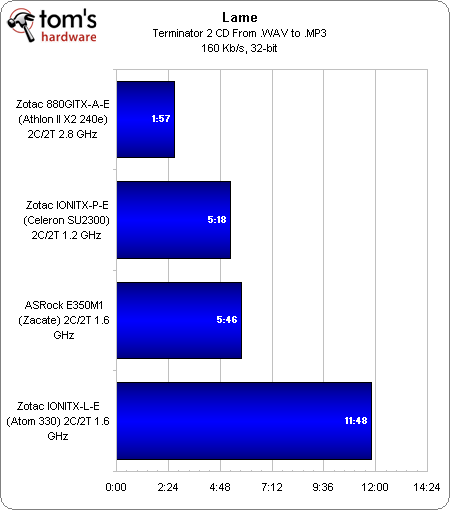ASRock's E350M1: AMD's Brazos Platform Hits The Desktop First
We had the opportunity to preview the Zacate APU late last year at AMD’s headquarters in Austin, Texas. Now we have the first retail motherboard based on the Brazos platform in ASRock’s E350M1. Today we’re asking: what can the Fusion initiative really do?
Benchmark Results: Productivity
Our threaded Photoshop CS5 test definitely favors the low-power Athlon II. Intel’s Celeron SU2300 also fares well, followed by AMD’s E-350. The Atom/Ion combination brings up the rear.
If ASRock’s E350M1 is part of a productivity-oriented machine, then it’s feasible that it’ll need to interact with a scanner and OCR software. Naturally, AMD’s desktop architecture reigns supreme here. But the Celeron, E-350, and Atom all fall within four minutes of each other (a veritable lifetime in the world of high-end CPUs, but relatively less in the power-optimized market).
Converting a WAV file to MP3 is another fairly realistic usage case for a low-power system. And what we see here is interesting. Lame is not threaded, so it’s certainly not surprising to see the 2.8 GHz processor tearing things up. More surprising is that Intel’s efficient Celeron SU2300 takes second place, with its 1.2 GHz clock. The E-350 is right behind, running at 1.6 GHz. And the Atom, with its in-order execution pipeline gets far less done at the same 1.6 GHz clock rate.
This is a result you’ll see again—so keep in mind that Atom really needs the parallelism enabled by a second core and Hyper-Threading to fully maximize its performance.
The same issues trouble Atom here in WinZip, which also isn’t threaded. The 1.6 GHz processor struggles to get the workload completed compared to AMD’s E-350, which runs at the same clock rate, but employs a more performance-oriented architecture. In fact, the Zacate APU is only a minute and a half slower than the 1.2 GHz Celeron SU2300, based on Intel’s Core 2 microarchitecture.
WinRAR is able to take advantage of processors with multiple cores, and the Atom’s loss isn’t as pronounced. Again, AMD’s desktop architecture takes the top spot, following by Intel’s 10 W Celeron, the E-350, and Intel’s Atom 330.
Get Tom's Hardware's best news and in-depth reviews, straight to your inbox.
Current page: Benchmark Results: Productivity
Prev Page Benchmark Results: Sandra 2011 Next Page Benchmark Results: Media Encoding-
iam2thecrowe now they need some devs to take advantage of that apu to see its full potential as a processor.Reply -
Reynod This is an awesome processor ...Reply
Chris ... did you manage to overclock it at all?
Give it your best shot ... call crashman in with the liquid nitrogen if you need to mate !!
Really impressive stats for such a small piece of silicon. -
dogman_1234 So the Brazo is great for media and hard processing I assume. If someone came to me and asked for a good platrom to watch Blu-Ray...I would say get the Brazo APU for them, right?Reply -
sparky2010 Nice, things are starting to look good for AMD, and i hope it stays that way as they start unveiling their mainstream and highend processors, because i'm really fed up with intel dictating crazy prices.....Reply -
cangelini reynodThis is an awesome processor ... Chris ... did you manage to overclock it at all?Give it your best shot ... call crashman in with the liquid nitrogen if you need to mate !!Really impressive stats for such a small piece of silicon.Reply
Didn't get a chance to mess with overclocking. If this is something you guys want to see, I might try to push it a little harder over the weekend. -
joytech22 cangeliniDidn't get a chance to mess with overclocking. If this is something you guys want to see, I might try to push it a little harder over the weekend.Reply
Yeah that would be much appreciated, these little chips are so much faster than Atom, let's see if you can get them to perform similarly to a Dual-Core CPU at 1.8GHz -
cangelini Alright, I'll see what I can do. A shiny new video card landed this afternoon, so that's going to monopolize the bench for much of the weekend ;)Reply -
dEAne Yes integration is the key to higher performance, lower power consumption and lower price (affordability this is what people really wanted).Reply -
haplo602 can you also run gaming benchmarks with a 5670 or similar plugged into the PCIe slot ? Just to have a look how the limited memory interface will bottleneck ...Reply
also what happens with the intgrated graphics core when you plug in a discreet GPU ? you gave so much detail about this in the sandy bridge review but totaly skip it for Fusion ...
the board got me interested. I am trying to buy a small "workstation terminal" ... something to code OpenGL/OpenCL on a budget. Seems this is what I am looking for.






